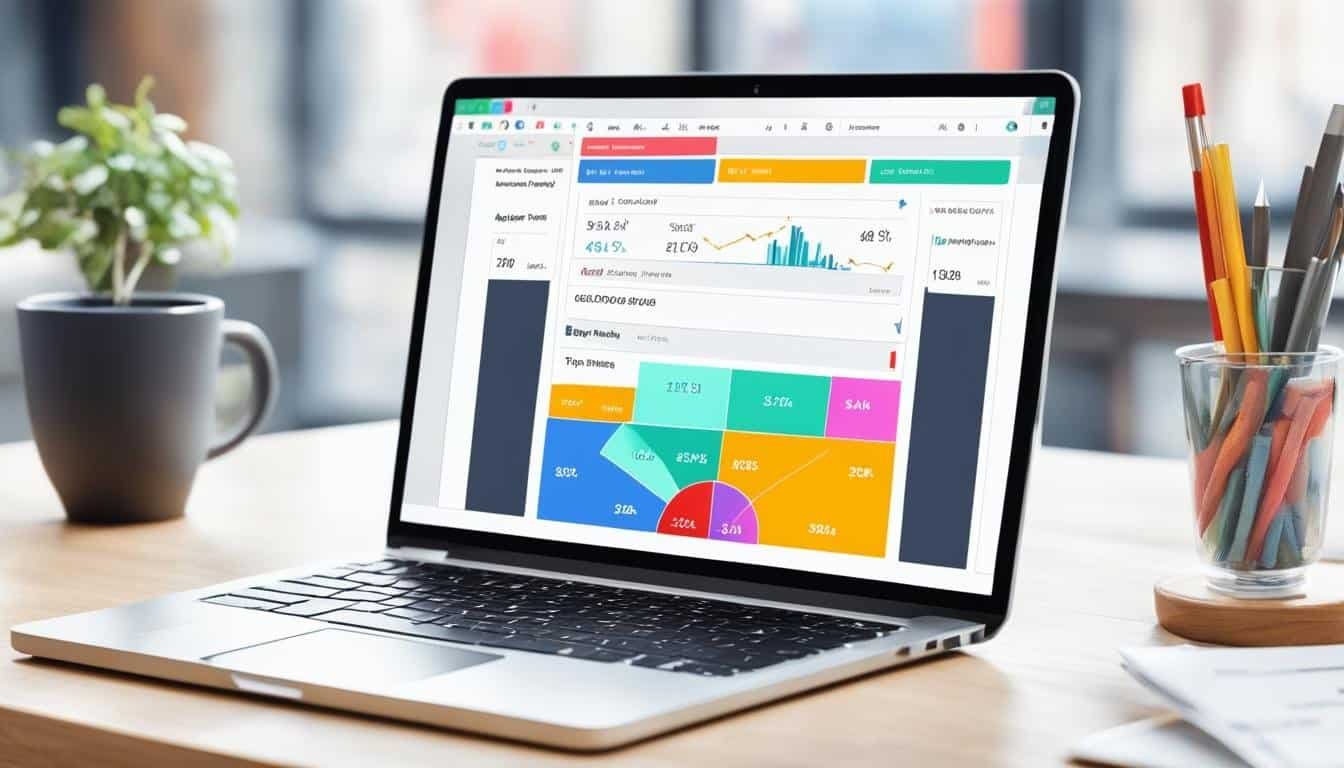Boost Sales with Personalization in Email Marketing
Email marketing is a powerful tool for businesses to increase sales and customer engagement. Personalization in email marketing can significantly improve results, with statistics showing that 80% of consumers are more likely to make a purchase from a brand that provides personalized experiences. Additionally, 90% of U.S. consumers find marketing personalization appealing. By utilizing personalization strategies in email marketing campaigns, businesses can create targeted and tailored content that resonates with their audience, ultimately driving sales.
Key Takeaways:
- Personalization in email marketing can significantly improve sales and customer engagement.
- 80% of consumers are more likely to make a purchase from a brand that provides personalized experiences.
- 90% of U.S. consumers find marketing personalization appealing.
- By utilizing personalization strategies in email marketing campaigns, businesses can create targeted and tailored content that resonates with their audience.
- Personalization in email marketing is a key factor for driving sales and increasing customer loyalty.
The Importance of Personalization in Email Marketing
Personalization is a cornerstone of successful email marketing, driving sales, customer engagement, customer experience, and reinforcing the brand persona. By tailoring email content to meet individual preferences, businesses can create a more meaningful and impactful connection with their audience. When combined with a robust Customer Relationship Management (CRM) system, personalized email marketing campaigns can effectively nurture and close high-value customers, resulting in a higher return on investment (ROI).
Research has shown that encountering non-personalized content deters 66% of consumers from making a purchase. Moreover, 63% of online shoppers would stop buying from brands that employ poor personalization tactics. This highlights the significance of personalization throughout the entire sales process, from prospecting to customer retention.
“Personalization is not just about addressing a recipient by their name; it’s about creating tailored experiences that resonate with individuals, fostering a sense of connection and relevance.”
When personalized emails are delivered, they not only grab attention but also offer a more engaging and satisfying customer experience. By using relevant customer data to deliver targeted messages, businesses can address pain points, provide relevant information, and offer tailored solutions. Consequently, personalized emails drive higher customer engagement, encourage click-throughs, and increase the likelihood of conversions.
Building a strong brand persona is another benefit of personalization in email marketing. By delivering consistent and personalized messages, businesses can shape their brand identity and differentiate themselves from competitors. This helps to establish trust, enhance brand loyalty, and create a lasting impression in the minds of customers.
Embracing personalization in email marketing is not just a recommendation; it has become a necessity in today’s competitive landscape. From segmented customer lists to dynamic content, businesses must invest in the tools and strategies that allow them to deliver personalized experiences at scale.
Key Benefits of Personalization in Email Marketing:
- Increased customer engagement and satisfaction
- Higher open and click-through rates
- Improved customer experience
- Stronger brand persona and differentiation
- Greater customer loyalty and retention
By prioritizing personalization in their email marketing efforts, businesses can unlock new opportunities, build stronger customer relationships, and drive sustainable growth.
Boosting Sales with Email Marketing
Email marketing is an effective strategy for boosting sales, especially for B2B businesses. It allows for personalized communication with prospects and customers, increasing the likelihood of conversions. One of the key strategies for maximizing sales with email marketing is segmentation. By segmenting the email list based on specific criteria such as demographics, behavior, or past purchases, businesses can tailor their emails to specific audience segments, improving open and conversion rates. Additionally, targeted email marketing, where emails are sent to a select group of individuals who are more likely to be interested in the message, can further enhance sales results.
Segmentation helps businesses deliver more relevant and targeted content to their audience. By dividing the email list into segments, you can create personalized campaigns tailored to the specific needs and preferences of each group. This allows you to engage with your audience on a deeper level and deliver content that resonates with them.
Targeted email marketing takes segmentation a step further by sending emails to a select group of individuals who are more likely to be interested in the message. Instead of sending a generic email to your entire list, you can narrow down your audience to those who have shown a specific interest or have certain buying behaviors. This approach increases the relevance of your emails and significantly improves your chances of driving sales.
Benefits of Email Segmentation and Targeted Marketing
Segmentation and targeted marketing in email campaigns offer several benefits that can boost your sales. Here are the key advantages:
- Increased Open Rates: By sending personalized emails to specific segments, you can capture the attention of your audience and increase open rates. When your emails align with your subscribers’ interests, they are more likely to open and engage with your content.
- Improved Conversion Rates: Personalized and targeted emails can lead to higher conversion rates. When you tailor your messages based on your audience’s preferences, needs, and behaviors, you increase the relevance of your offers, making it more likely for recipients to take action.
- Enhanced Customer Satisfaction: Email segmentation allows you to send content that is relevant and valuable to each segment. This personalized approach shows your subscribers that you understand their needs and interests, leading to increased customer satisfaction and loyalty.
- Cost-Effectiveness: By focusing your efforts on targeted segments, you can optimize your resources and avoid wasteful spending. Instead of sending emails to a broad audience who may not be interested, you can direct your resources towards those most likely to convert, maximizing your return on investment.
In order to implement effective segmentation and targeted marketing strategies, it’s crucial to have access to a reliable email marketing platform that offers advanced segmentation features. With the right tools in place, you can easily manage and analyze your segmented lists, create personalized content, and track the performance of your campaigns.
Email Segmentation and Targeted Marketing Example
Let’s take a look at an example of how email segmentation and targeted marketing can be applied in practice:
| Segment | Criteria | Email Content |
|---|---|---|
| New Subscribers | Subscribers who have recently joined your email list | Welcome emails, introducing your brand and providing a special offer for their first purchase |
| Abandoned Carts | Subscribers who have added products to their cart but haven’t completed the purchase | Reminders about their abandoned carts with personalized product recommendations and incentives to complete the purchase |
| Repeat Customers | Customers who have made multiple purchases | Loyalty rewards, exclusive offers, and personalized product recommendations based on their purchase history |
By segmenting your email list and creating targeted content for each segment, you can deliver personalized experiences that drive engagement and sales. Whether it’s welcoming new subscribers, enticing abandoned carts, or rewarding loyal customers, segmentation and targeted marketing enable you to connect with your audience in a meaningful way.
Next, we’ll explore the techniques for creating compelling personalized emails that capture your audience’s attention and drive conversions.
Personalization Techniques for Sales Emails
To personalize sales emails effectively, there are several techniques that can be employed. One of the most effective ways is to use dynamic email content, which allows for the customization of email body and subject lines based on recipient attributes. Personalized subject lines that include the recipient’s name or other relevant personalized information can significantly increase open rates. Including social proof, such as previous case studies or positive customer testimonials, in the emails can also build trust and encourage recipients to engage further.
Dynamic email content is a powerful tool that enables you to tailor your messages to each individual recipient. By inserting personalized fields within your email body, you can address your customers by their name and other relevant details, creating a sense of connection and relevance. This level of personalization shows that you understand and care about their needs, increasing the likelihood of a positive response.
“Dynamic email content allows you to create personalized experiences for your customers, making them feel valued and appreciated.”
In addition to dynamic content, personalized subject lines can make a significant impact on the success of your sales emails. By including the recipient’s name or other relevant information in the subject line, you can grab their attention and increase the chances of your email being opened. Research has shown that personalized subject lines can improve open rates by up to 26%.
Another effective technique is to include social proof in your sales emails. Social proof refers to showcasing positive customer testimonials or case studies that demonstrate the value of your products or services. By highlighting the experiences and successes of satisfied customers, you can build trust and credibility, encouraging recipients to take action.
Benefits of Personalization Techniques in Sales Emails:
- Improved Open Rates: Personalized subject lines increase the likelihood of your emails being opened.
- Enhanced Engagement: Dynamic email content and social proof create a personalized experience that encourages recipients to engage further.
- Building Trust: Including customer testimonials and case studies establishes credibility and builds trust with your audience.
- Higher Conversion Rates: By personalizing your sales emails, you can increase the chances of conversions and ultimately drive sales.
| Technique | Benefits |
|---|---|
| Dynamic Email Content | Customized messages based on recipient attributes |
| Personalized Subject Lines | Increased open rates and attention |
| Social Proof | Builds trust and credibility |
Segmenting the Email List for Personalization
Segmenting your email list is a critical step in personalizing your email marketing campaigns. By dividing your list into smaller, more targeted groups based on specific criteria, you can provide more relevant and personalized content to your recipients. This not only improves the effectiveness of your campaigns but also enhances the overall customer experience.
One of the key benefits of email list segmentation is the ability to tailor your messages to different segments of your audience. By understanding the unique needs, interests, and preferences of each segment, you can create content that resonates with them, increasing engagement and conversions.
Segmentation can be done using a Customer Relationship Management (CRM) system, which allows you to import users and create custom attributes for segmentation. By integrating your CRM with your email marketing tools, you can streamline the process of segmenting your email list and sending targeted campaigns to each segment.
Here’s an example of how you can segment your email list for B2B marketing personalization:
| Segment | Criteria |
|---|---|
| B2B Businesses | Companies that operate in the B2B sector |
| Job Title | Segment based on job titles, such as CEOs, marketing managers, or sales executives |
| Industry | Segment based on industry types, such as technology, healthcare, or finance |
| Company Size | Segment based on the number of employees, such as small businesses, mid-sized companies, or large enterprises |
By segmenting your email list based on these criteria, you can create highly targeted and personalized email campaigns that address the specific needs and pain points of each segment. This level of personalization in your B2B marketing can significantly improve the effectiveness of your campaigns and drive better results.
Segmenting your email list and integrating a CRM system with your email marketing tools enables you to deliver personalized content to your audience effectively. It allows you to send the right message to the right people at the right time, resulting in higher engagement, conversion rates, and overall campaign success.
Crafting Compelling Personalized Emails
Crafting compelling personalized emails is essential for successful email marketing. It starts with creating relevant content that addresses the pain points and interests of your target audience. Personalization goes beyond using the recipient’s name; it involves tailoring the content to their unique preferences, interests, and purchase history. By understanding your audience and segmenting your email list effectively, you can deliver personalized messages that resonate with each recipient.
One effective way to personalize your emails is by including personalized fields in the email body. For example, you can reference a recent activity or purchase by the recipient and acknowledge their engagement. This not only adds a personal touch but also shows that you value their interactions with your brand.
“We noticed that you recently purchased one of our products and we wanted to say thank you! We hope you’re enjoying it and that it’s meeting your expectations. If you have any questions or need further assistance, don’t hesitate to reach out to our customer support team.”
In addition to personalized content, it’s essential to present yourself professionally. Including a professional email signature adds credibility to your emails and makes them more memorable. An email signature typically includes your name, job title, contact information, and relevant links such as your LinkedIn profile or personal blog.
Here’s an example of a professional email signature:
Best regards,
John Smith
Marketing Manager
XYZ Corporation
Phone: 123-456-7890
LinkedIn: linkedin.com/in/johnsmith
By crafting compelling personalized emails with relevant content and a professional email signature, you can make a lasting impression on your recipients and drive engagement with your email marketing campaigns.
Leveraging Personalization Tools for Email Marketing
Enhancing your email marketing efforts with personalization tools can significantly improve customer engagement and campaign effectiveness. With the right tools, you can easily create personalized email campaigns that resonate with your audience, leading to higher open and conversion rates. In this section, we will explore some of the top personalization tools available and how they can help you optimize your email marketing strategy.
Moment: Your All-in-One CRM Solution
One powerful personalization tool that offers a range of features is Moment’s free CRM. With Moment, you can access multiple tools within one platform, including email marketing and chat automation. This integration streamlines your marketing efforts, allowing you to seamlessly execute personalized email campaigns without the need for separate tools.
Moment’s CRM provides the flexibility to import users and segment them based on custom attributes. This segmentation capability enables you to create targeted email campaigns that speak directly to your recipients’ interests and preferences. By leveraging Moment’s CRM integration, you can achieve a unified approach to personalized marketing, enhancing your overall campaign performance.
Other Personalization Tools to Consider
While Moment is an excellent choice for free email marketing and CRM integration, there are other personalization tools worth exploring. These tools offer a variety of features to enhance your email marketing campaigns and drive better results:
- Personalization Engine: This tool utilizes advanced algorithms to deliver hyper-personalized content based on user behavior and preferences.
- Email Segmentation Software: This software allows you to segment your email list based on various criteria, such as demographic data, purchase history, or engagement levels.
- Dynamic Content Generator: With this tool, you can create dynamic email content that adapts to the recipient’s attributes in real-time, resulting in highly relevant and engaging emails.
- Marketing Automation Platforms: These platforms combine email marketing, CRM, and automation capabilities to streamline your personalized email campaigns and deliver targeted messages at scale.
By leveraging these personalization tools, you can take your email marketing strategy to the next level, delivering personalized experiences and optimizing your campaign performance.
Personalization Tips for Boosting eCommerce Sales
Personalization is a crucial strategy for driving eCommerce sales through email marketing. By tailoring your email campaigns to meet the unique needs and preferences of your target audience, you can increase engagement and ultimately boost sales. Here are some tips to help you personalize your email marketing efforts:
1. Segment your audience based on buyer persona
To deliver relevant and personalized content, it’s important to segment your email list based on the specific characteristics and behaviors of your buyers. By understanding your target audience’s past preferences, browsing history, demographic data, and behavior, you can create more targeted and personalized email campaigns.
2. Customize emails based on recipient data
Go beyond simply addressing your recipients by their names. Use the recipient’s data to create customized content that speaks directly to their interests and needs. Personalize your emails based on their past purchases, browsing history, and demographics. This level of personalization shows your customers that you understand them and can provide solutions tailored to their specific needs.
3. Leverage automation tools for email personalization
Automating your email personalization processes can save time and ensure consistency in delivering personalized content. Use automation tools that integrate with your eCommerce platform and CRM to streamline the process of collecting and utilizing customer data for personalization. By automating the personalization process, you can efficiently deliver personalized content at scale and increase the effectiveness of your email marketing campaigns.
4. Test and iterate to optimize personalization
Testing is key to optimizing your personalization efforts. Continuously monitor and analyze the performance of your personalized email campaigns. Track metrics such as open rates, click-through rates, and conversion rates to understand how well your personalization strategies are resonating with your audience. Make adjustments to your approaches based on the data-driven insights you gather to continually improve the effectiveness of your email marketing efforts.
5. Provide personalized product recommendations
One effective way to personalize your email campaigns is by providing product recommendations based on customer data. Utilize browsing and purchase history to suggest products that align with the recipient’s interests and preferences. By offering personalized recommendations, you can increase the chances of driving conversions and upsells.
6. Use dynamic content to personalize emails
Dynamic content allows you to customize different elements of your emails based on recipient attributes. Tailor subject lines, images, and product offers to match the recipient’s preferences and behavior. This level of personalization enhances the relevance and effectiveness of your email campaigns, leading to higher open and click-through rates.
Implementing these personalization tips in your email marketing campaigns can significantly impact your eCommerce sales. By delivering targeted and tailored content to your audience, you enhance engagement and create a more personalized customer experience. Remember to continuously evaluate and refine your personalization strategies to ensure maximum effectiveness and drive ongoing sales growth.
Six Ways to Personalize eCommerce Email Marketing Campaigns
To maximize the effectiveness of your eCommerce email marketing campaigns, it’s essential to employ personalized strategies. By tailoring your emails to each recipient’s needs and preferences, you can increase engagement, enhance customer satisfaction, and boost conversion rates. Here are six effective methods to help you personalize your email marketing campaigns:
1. Target Audience Segmentation
Segmenting your email list allows you to customize your content based on common attributes among recipients. By dividing your audience into smaller, more targeted groups, you can deliver tailored messages that resonate with each segment. Consider using criteria such as demographics, purchasing behavior, or engagement level to create personalized email campaigns.
2. Personalized Email Content
To engage your audience and drive conversions, focus on crafting email content that is tailored to each recipient’s unique interests and preferences. Use data insights and customer information to create relevant and personalized messages that speak directly to their needs. By showing that you understand their individual preferences, you’ll establish a deeper connection and increase the likelihood of conversion.
3. Personalized Product Recommendations
Utilize customer data and purchase history to provide personalized product recommendations and promotions. By showcasing items that align with the recipient’s interests or past purchases, you can increase the chances of conversion. Personalized product recommendations demonstrate that you understand your customers’ preferences and can guide them towards products they are likely to be interested in.
4. Trigger-Based Automation
Implementing trigger-based automation in your email marketing campaigns allows you to send timely and relevant content to your recipients. Set up automated emails such as cart abandonment reminders, welcome emails, and post-purchase follow-ups to nurture your leads and maintain engagement. Trigger-based automation ensures that your messages are delivered at the right moment, increasing the likelihood of conversion and improving customer satisfaction.
5. Leverage Relevant Data
Take advantage of recent events, job openings, or new team members to enhance the personalization of your emails. Incorporating this information into your email content shows that you care about staying up-to-date and relevant to your recipients’ lives. By leveraging relevant data, you can create a sense of connection and increase the chances of engagement and conversion.
6. Follow-Up on Personalized Emails
Following up on personalized emails is crucial for maintaining engagement and establishing a strong connection with your recipients. Send follow-up emails to check if they have any questions or need further assistance. This gesture shows that you value their interaction and are committed to providing exceptional customer service. Following up also provides an opportunity to nurture the relationship further and potentially drive additional conversions.
By implementing these six methods, you can personalize your eCommerce email marketing campaigns to resonate with your audience and drive meaningful results. Remember that personalization goes beyond addressing recipients by name; it involves creating tailored content that meets their specific needs and desires. Combine these strategies with a well-planned email marketing campaign and watch your engagement and conversions soar.
Conclusion
Personalization meets automation in email marketing to create a powerful strategy that drives sales and boosts engagement. By employing various personalization techniques and leveraging tools, businesses can create targeted and tailored email campaigns that resonate with their audience, leading to increased conversions.
However, the journey doesn’t end there. To maximize the effectiveness of email personalization, it is crucial to track performance and analyze results. By monitoring key metrics such as open rates, click-through rates, and conversion rates, businesses can gain valuable insights into the effectiveness of their personalization efforts. This data-driven approach enables continuous refinement and improvement, allowing businesses to iterate and optimize their email marketing strategy.
By combining personalization with automation, businesses can streamline their email marketing processes and ensure timely and relevant content delivery. Automation tools, such as trigger-based emails and dynamic content, enhance the personalization experience and save time for marketers.
In conclusion, the marriage of personalization and automation in email marketing offers immense potential for businesses to connect with their audience on a deeper level. By tracking performance, iterating on strategies, and leveraging automation tools, businesses can unlock the true power of personalized email campaigns, driving sales and fostering customer loyalty.







